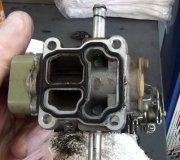First of all, thank you for your patience with my car.
I was thinking of relisting the problems also.
The problems present are the following.
1) It is impossible to change between gears 1, 2 and 3 smoothly (car loses power of something when clutch pressed in). This problem is not present when electrical load is turned off.
2) When I either press the clutch or let the gear to neutral, the RPM sometimes drop too low (under 500) and then goes up
3) The car vibrates at idle. Nowadays when driven a short while, the problem goes away (before the problem wasn't there when the car was started, but after a little driving)
4) The alternator (not the belt) makes whining noise that increases with electrical load or with RPM to 2500RPM, then disappears.
5) There is actually no deceleration, impossible to stop the car without brakes when in gear (tries to go forward). When in 2nd gear, the car goes 15mph without touching the gas pedal, won't stop it goes uphill. I actually drove like this around a block several times in a row, it just keep moving.
6) Occasional slight smell of some fumes (fuel? Sulphur?) While driving, and after driving.
7) When the car stops moving, the RPM makes a little notch (750->600->700)
8) The engine temperature meter needle stays a bit below the center point, I remember it was at the center with the old engine.
Last August the engine of the car was changed (only the engine, all supplements were from the old engine), since the old one leaked oil into the exhaust system. I noticed the symptoms 1) and 4) before the engine change (possibly after the first time the battery had been disconnected for a longer while, ECU failed relearning?).
Before the engine change couple of the passenger side front wheel's bolts came off while driving, resulting in destructing the wheel and excessive vibration while driving (broke something?)
All worked OK after I changed the wheel.
Other problems came after the engine change, where again the battery was disconnected for a few days. The problems also include stalling when coming to a stop, but this hasn't happened since last October. The awful smell mentioned in this topic hasn't appeared after the clutch plate change.
The list of replaced parts so far includes:
Battery
Alternator to battery wiring
Battery to ground wiring.
Battery negative terminal
Alternator and P/S belts
Alternator (4 times)
IAC control motor
EGR valve
Fuel injectors and fuel pressure regulator
Camshaft position sensor
Air filter
Spark plugs
Ignition lock
PCV valve
Camshaft pulleys
Clutch plate
Neutral gear switch
Throttle body gasket
Clutch release cylinder
I have also cleaned the IAC valve and the throttle body. I also tried new spark plug wires without any change. I have also put both injector cleaner and valve cleaner into the gasoline without any results as well as tried higher octane gasoline.
The brake cleaner has been applied to everywhere in the engine bay to find vacuum leaks or inspect the intake manifold gasket, doesn't affect anything.
The timing belt has been checked several times, it's correctly placed.
I've tried to change the idle speed, doesn't help.
The engine/emissions wiring harness has been tested from every pin of the ecu to the sensors, all OK. Also extra ground wires added to the headlights and engine. Every grounding point of the car visually inspected.
Some mechanic said to me that my ECM/PCM might be broken. I can't believe this since the car sometimes does work. The new ECM/PCM costs 1800 euros (way over 2000$) here so I can't afford to "test" a new one, I need to be sure of it being broken before buying a new one. An ECM from the scrapyard is impossible to fit the car due the immobilizer.
The power consumption of the car is measured by an electrician, with full load 35A. The battery voltage as well as the voltage from the alternator is OK.
The car works occasionally fine. There are two reasons which sometimes result in the car working fine:
1) Driving without any electrical load
2) After a fast acceleration.
Well, it's a long list but that should be all. When the car sometimes works fine, I'll be sure to make another donation.
Thursday, May 28th, 2009 AT 1:05 AM


